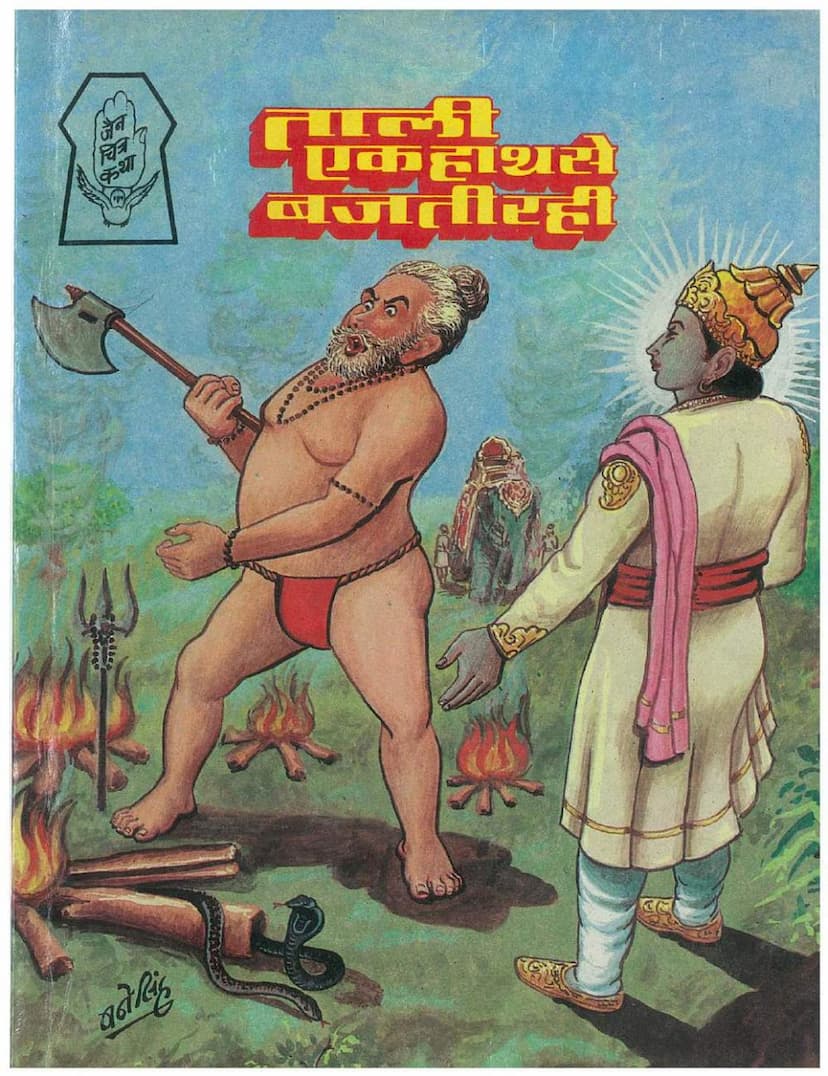Tali Ek Hath Se Bajti Rahi
Added to library: September 2, 2025

Summary
Here's a comprehensive summary of the Jain text "Tali Ek Hath Se Bajti Rahi" by Moolchand Jain, based on the provided pages:
Book Title: Tali Ek Hath Se Bajti Rahi (A Clapping Hand Always Struck Itself) Author: Dr. Moolchand Jain Publisher: Acharya Dharmshrut Granthmala
Core Theme and Message:
The central message of the book, as conveyed through its title and the introductory remarks, is about self-restraint, patience, and the consequences of negative actions, often illustrated by the concept of "a clapping hand always struck itself." This implies that harmful actions ultimately rebound on the perpetrator. The book uses the life story of Lord Parshvanatha as a primary example to teach these values.
Key Narrative and Illustrative Examples:
The book unfolds the story through a series of past lives and the life of Lord Parshvanatha, highlighting the Jain principle of karma and its inexorable influence.
-
The Cycle of Enmity: Kamatha and Marubhuti:
- The narrative begins by introducing Kamatha and Marubhuti as brothers in past lives.
- Kamatha's character is depicted as malicious and vengeful, consistently harming Marubhuti across multiple lifetimes.
- Marubhuti, conversely, embodies patience, forbearance, and spiritual inclination. This stark contrast illustrates the book's core theme of how negative actions lead to downfall, while peacefulness leads to progress.
- Kamatha's repeated acts of violence and enmity ultimately lead him to suffer in lower realms of existence (hells), while Marubhuti's patient and virtuous conduct propels him towards higher spiritual states.
-
The Birth and Early Life of Lord Parshvanatha:
- The story then transitions to the immediate past life of Lord Parshvanatha. Marubhuti's soul is reborn as Prince Parshvanatha, the 23rd Tirthankara.
- The narrative recounts the auspicious signs of his conception (like Queen Vama Devi seeing sixteen dreams) and his birth.
- The celestial beings (devas) celebrate his birth with great fanfare, performing a symbolic coronation (Janm Kalyanak) on Mount Meru.
- The book details the divine procession, the bringing of the infant Parshvanatha to his parents (King Ashwasen and Queen Vama Devi), and the subsequent festivities.
-
Prince Parshvanatha's Renunciation:
- As Prince Parshvanatha grows, he witnesses the transient nature of worldly pleasures and the inevitability of old age and death.
- He demonstrates a profound detachment from worldly life, including marital bliss, despite his parents' wishes.
- At the age of thirty, inspired by a divine messenger (Laukantik Dev) and the example of Lord Rishabhadeva, he embraces Muni Diksha (asceticism), renouncing his princely life.
-
The Penance and Overcoming Obstacles:
- As a muni, Parshvanatha undertakes severe penances and meditation.
- The narrative describes Kamatha's soul, now in the form of a dev (Samvara), trying to obstruct Parshvanatha's penance. This is depicted as the "clapping hand" striking itself, as Kamatha's actions of harassment ultimately lead him to experience the consequences of his actions.
- Lord Parshvanatha endures severe upasargas (afflictions) without complaint.
- The story highlights the role of Dharanendra and Padmavati (snake-king and queen) who, having heard the Namokar Mantra from Parshvanatha in a previous life, intervene to protect him from Samvara's attacks. They shield him from the elements, demonstrating the power of gratitude and devotion.
-
Attainment of Omniscience and Nirvana:
- Through his unwavering penance and the eradication of his ghatiya karma (karma that obscures knowledge, perception, and conduct), Prince Parshvanatha attains Keval Gyana (omniscience) and becomes a Tirthankara.
- The text describes the establishment of the Samavasarana (divine assembly) where Lord Parshvanatha delivers his teachings.
- The narrative concludes with Lord Parshvanatha performing his Nirvana Kalyanak on Sammeta Shikhar, shedding his remaining aghatiya karma and achieving liberation (Moksha). His soul merges with the pure, formless state, never to return to the cycle of birth and death.
Illustrative Concepts and Jain Principles:
- Karma: The book consistently illustrates how actions (karma) have direct and far-reaching consequences across lifetimes. Kamatha's persistent negative actions lead him through various difficult births and realms, while Marubhuti's (Parshvanatha's) virtue leads to spiritual progress and eventual liberation.
- Patience and Forbearance (Kshama): Marubhuti and Parshvanatha exemplify these virtues, enduring hardship without retaliation.
- Renunciation (Vairagya): The book emphasizes the importance of detachment from worldly possessions and pleasures as a path to spiritual liberation.
- The Namokar Mantra: Its efficacy is highlighted as a means to purify consciousness and overcome karmic obstacles.
- The Five Great Vows (Mahavratas): While not explicitly detailed for every birth, the adherence to non-violence, truthfulness, non-stealing, chastity, and non-possession is implicit in the virtuous lives.
- The Cycle of Birth and Death (Samsara): The narrative clearly depicts the soul's journey through various existences driven by karma.
Educational and Inspirational Value:
The book is presented as an educational tool, particularly for younger generations, through the use of Jain picture stories. It aims to impart moral and spiritual lessons, fostering character development by showcasing the exemplary lives of great souls. The message encourages readers to learn from these stories and cultivate virtues like patience, compassion, and detachment in their own lives.
In essence, "Tali Ek Hath Se Bajti Rahi" is a Jain narrative that powerfully uses the life of Lord Parshvanatha to illustrate the fundamental Jain doctrines of karma, reincarnation, and the ultimate goal of liberation through righteous living and spiritual discipline.